Cuéllar
Cuéllar (Spanish pronunciation: [ˈkweʎaɾ]) is a small Town and Municipality in the Province of Segovia, in the autonomous community of Castile and León, in Spain. It had a population of 8,316 in 2019.[2]
Cuéllar | |
|---|---|
Town and Municipality | |
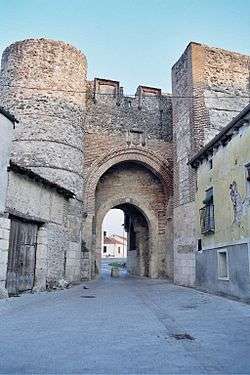 Arch of San Basilio | |
 Flag 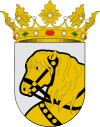 Seal | |
 Cuéllar  Cuéllar | |
| Coordinates: 41°23′N 4°21′W | |
| Country | |
| Autonomous community | |
| Province | Segovia |
| Municipality | Cuéllar |
| Elevation | 858 m (2,815 ft) |
| Population (2018)[1] | |
| • Total | 9,584 |
| • Density | 27.89/km2 (72.2/sq mi) |
| Website | http://www.aytocuellar.es |
The town is settled on a hill, and it is 60 km north-east of the capital city of Segovia, and 50 km south of Valladolid. It has an extension of 272 km² and it is 857 m above sea level. Flowing through the town are the rivers Cerquilla and Cega. To the north, the town borders the municipality of Bahabón (province of Valladolid); to the south it borders Sanchonuño; to the east is Frumales; and to the west are the municipalities of San Cristóbal de Cuéllar and Vallelado.
Cuéllar has a long-standing agriculture tradition. Specific crops are cereals, vegetables, chicory, legumes, and beet. Specific livestock raised are pigs, sheep and cows. Many years ago, forestry and resin production were important economic resources too.
History
There is some evidence of scattered Iron Age settlements in the upper area, near the castle. Roman settlements have not been discovered in the town.
Medieval Age
Professor Ubieto Arteta showed that there is some historical evidence of Cuéllar in the 10th century. Al-Mansur Ibn Abi Aamir (Spanish name: Almanzor) sacked the town and enslaved its population, deporting them to Andalusia. King Alfonso VI of León and Castile rebuilt the town again and brought new settlers at the end of the 11th century. This was the origin of the municipality, ruled by its town council. In 1184, king Alfonso VIII of Castile assembled the parliament in Cuéllar; there, he granted knighthood to several noblemen, amongst whom the Count of Tolosa.
In the 13th century, Cuéllar was one of the most important towns in the north of Spain. The wool trade enriched the local economy. Many palaces and Mudéjar churches were built. In 1256, Alfonso X of Castile granted Cuéllar a Royal Fuero (special law with privileges). Queen María de Molina, Sancho IV of Castile's wife, inherited the town after the death of her husband. The town was a refuge during her troubled regency while future King Ferdinand IV of Castile was a child.
In the middle of the 14th century, King Pedro I 'the Cruel' married doña Juana de Castro in Cuéllar. The marriage was a fraud because the King was divorced from his former wife in an unlawful way, and because he deserted doña Juana after their wedding night.
In 1464, King Henry IV of Castile gave the town as a Lordship to his favorite nobleman, Beltrán de La Cueva, the first Duke of Alburquerque. Since then, the town was bound to this family. His great-grandson was raised to Marquess.
Modern Age
In the 17th century, the town suffered a recession, along with many cities and villages in the country. The monarchy moved to Madrid and settled the court there, so the aristocracy also moved there. Also, it was a period of poverty because of the decadence of the wool trade, the taxes to pay the wars, and the plagues.
In the 18th century, thanks to the laws ruled by Charles III, the town recovered some of its social and economic prosperity.
When Napoleon invaded Spain, the town was looted by the French troops, who stole all the treasuries from the churches, monasteries and the castle.
In 1833, the writer and politician Jose de Espronceda was exiled to Cuéllar because of its liberalism ideology. He wrote the novel Sancho Saldaña o el castellano de Cuéllar when he was living near the church of Santo Tomé.
20th century
During the civil war, the town remained part of the country controlled by the nationalist forces so its churches were preserved from the destruction. The castle served as headquarters to the fascist Italian troops, and later as a prison for prisoners. Many years after, the castle was a hospital for consumption patients and a jail for criminals. Now it is a high school and tourism center. Due to the agriculture activities, the people of Cuéllar suffered less troubles after the civil war and did not emigrate as much as other people in the region.
Well-known people from Cuéllar
- Diego Velázquez de Cuéllar, Spanish conquistador.
- Bartolomé de la Cueva y Toledo, 16th century Roman Catholic cardinal
- Juan de Grijalva, Spanish conquistador. Some authors said he was from the same family as Diego Velázquez.
- Antonio de Herrera y Tordesillas, Spanish historian during the reigns of Philip II, Philip III and Philip IV.
- Gómez González de Cuéllar, deacon and founder of the Magdalena Hospital and a charity school in the 15th century.
- "Pipe" Gómez, professional cyclist racer.
Architecture
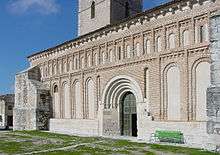
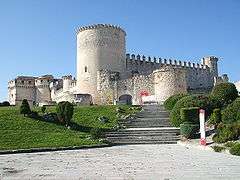
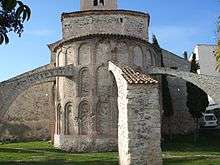

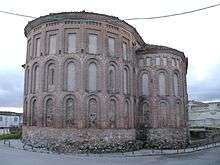
- San Martín Church (Cuéllar) (Iglesia de San Martín): It is a church built in the mudéjar stile in the 14th century. It is located near the Dukes of Alburquerque's castle. In 1997 a Center for the interpretation of Mudéjar Art was opened inside.
- San Andrés Church (Iglesia de San Andrés): There is historical evidence of its existence since 1277. It stood outside the walls of the town. It is considered as one of the most beautiful mudéjar churches in Spain.
- San Esteban Church (Iglesia de San Esteban): It stood between the first and second lines of the town walls. It is documented since 1247. Its apse is representative of the golden age of the mudéjar art. An ancient burial ground was discovered next to it.
- Santiago Church (Iglesia de Santiago): The apse is the only part of this mudéjar church that survives to date. The temple is documented since 1244. The records of the House of the Town Lineages, founded in the 14th century, were kept here.
- San Pedro Old Church (Antigua Iglesia de San Pedro): Dated since 1095, it was built in the south side of the walls. Its shape reminds a fortress. Some gothic structures remain in its tower and inside. It had to be sold by order of the civil government in the 19th century. It was used as a flour factory for many years. Nowadays it continues being a private property.
- Walls: They were built in the medieval age, around the 12th century. They were enlarged and rebuilt in the 14th and 15th centuries for defense. They are made of stone and lime. There are some arches along them. They have two different parts: one for the ancient citadel and an outer wall. They do not remain unbroken any longer because of the growth of the town, but there are several well-preserved sections besides the arches. They were declared national heritage site in 1931.
- Dukes of Alburquerque's Castle: The ancient fortress was built before the 11th century, though the current building was built in the XIV and 15th centuries, being named as castle in 1306. It is located in the top of a hill. It was restored to be a high school.
- School of Grammar (Estudio de Gramática) : Charity institution founded by deacon Gómez González in 1424. It is believed that Cardinal Cisneros visited the school, but it is unknown if he was a student or a teacher. The Renaissance facade remains.
- Pedro's I the Cruel Palace : Gothic palace built in the 14th century. Here, the king celebrated after marrying doña Juana de Castro in San Martin Church in 1353.
- Magdalena Hospital: Gothic building founded in 1429 by deacon Gómez González, too. It was a charity hospital.
- San Francisco Park: This nice park is surrounded by three old cloisters: Santa Isabel o Santa Ana, San Francisco, and The Immaculate Conception. Santa Isabel is expected to be restored. San Francisco was once the biggest temple in Cuéllar. It had the Duke's of Alburquerque tombs (they are in The Hispanic Society of America museum now). It had to be sold by order of the civil government and suffered a fire later; the building was nearly destroyed. Now it is used as Center for the Running of the Bulls. The Immaculate Conception was built following the Baroque style. Currently, nuns continue living in it.
- El Salvador Church: It has a Mudéjar apse with flying buttress, that gives its singular shape.
- Santa Clara Cloister: It has a renaissance facade and was one of the first gothic temples built in Cuéllar. Nuns have been living here since the 13th century.
- Santa Maria in The Hill Church: Its elegant tower can be view from many places. It is believed it was built by the Templars, however there is no evidence.
- Santa Marina Tower: It was part of a former mudéjar church and made of brick.
- Santo Tomé Church: Small gothic shrine.
- San Miguel Church: It is located in the square of the town hall. It shows a mix of different building styles, and has a gothic dome inside. It keeps a sculpture of Our Lady of the Rosary, religious sponsor of the town.
- The yard in the town hall: Small yard built in renaissance style.
- Ancient Trinity Cloister: It is regretfully in ruinous condition.
Festivals
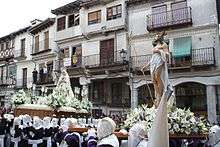
- Children's day: It is celebrated on New Year's Day. This is an old tradition, consisting in a procession centered in the Child of The Ball. The child is accompanied by musicians and dancers, and all are dressed in the 15th century clothes. They march through the town and many people use to join them.
- Running of the bulls: This festival is considered the oldest in Spain. It was dated since 1215, when a request was written to forbid priests to run with the bulls, but it is believed that the pagan tradition started before the Christianity. They are celebrated for 5 days, beginning on the last Saturday evening of August, and they honor Our Lady of the Rosary. Early in the morning, the bulls run from the corral near the river 5 km away to the bull-ring. They are guided by horsemen when they are in the pine-forest, and by the people when they arrive to town. Parties and celebrations join the running when people from everywhere enjoy the traditional dishes of roasted lamb and the regional wines.
- Annual Pilgrimage to the sanctuary of Our Lady of the Hayfield (Nuestra Señora del Henar): Every 17 September the devout people from the area go together to pray and to celebrate. This sanctuary is 5 km away from Cuéllar and it is a popular leisure place too.
References
- Municipal Register of Spain 2018. National Statistics Institute.
- https://www.citypopulation.de/php/spain-localities-segovia.php?cityid=40063000301. Missing or empty
|title=(help)
External links
![]()